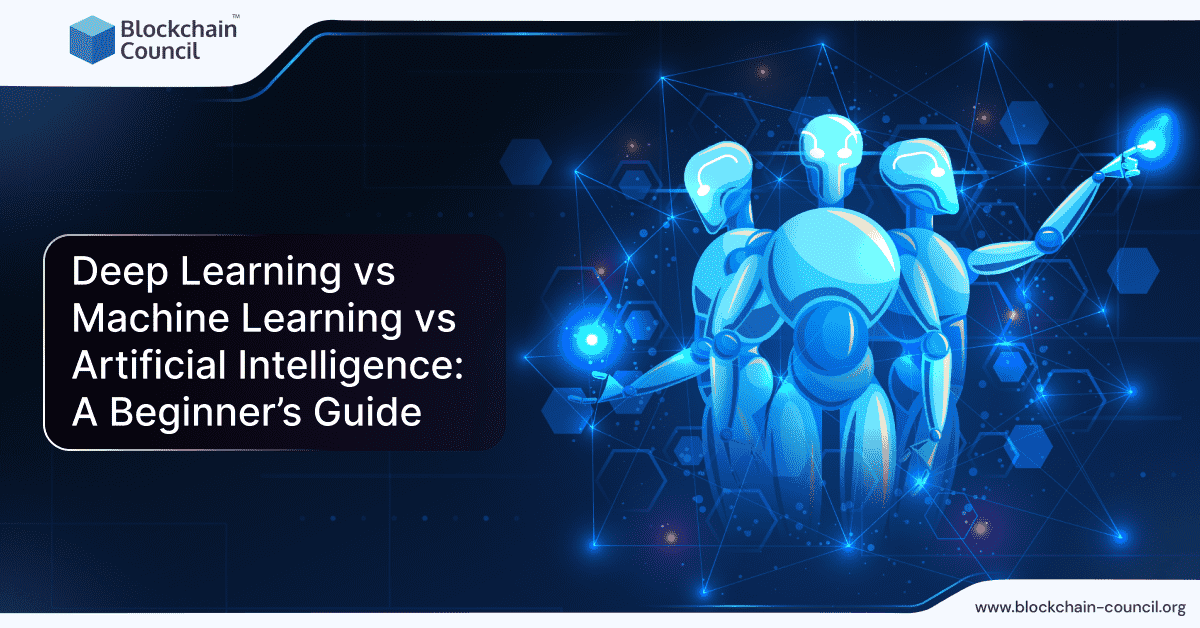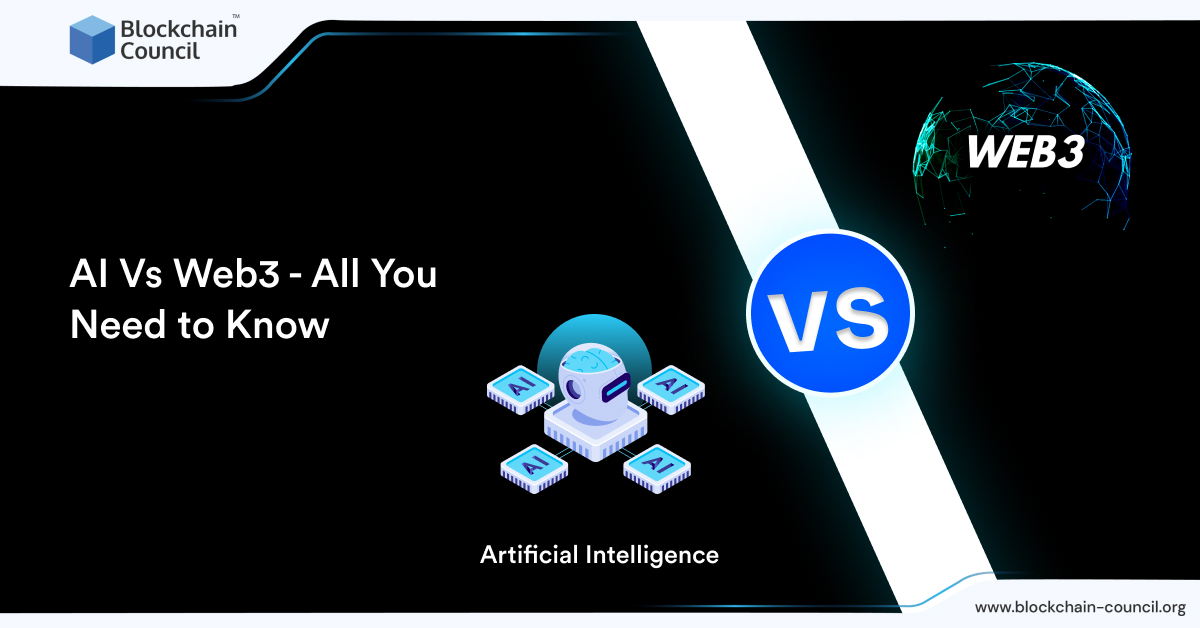
- Blockchain Council
- September 13, 2024
Artificial Intelligence (AI), Machine Learning (ML), and Deep Learning (DL) are three interwoven technologies driving the current wave of digital transformation. Each of these fields, while interconnected, has its distinct characteristics and applications.
Artificial Intelligence is the broadest concept, encompassing the idea of machines being able to carry out tasks in a way that we would consider “smart.” It’s a multidisciplinary science with multiple approaches, but advancements in machine and Deep Learning are creating a paradigm shift in virtually every sector of the tech industry.
Machine Learning, a subset of AI, is based on the idea that systems can learn from data, identify patterns, and make decisions with minimal human intervention. It involves algorithms that parse data, learn from that data, and then apply what they’ve learned to make informed decisions. An important trend in Machine Learning is the shift toward customized models that cater to specific needs, particularly in business applications. This customization allows for more precise, efficient, and secure applications in fields such as healthcare, finance, and legal sectors.
Deep Learning, a subset of ML, involves neural networks with many layers (hence “deep”). These neural networks attempt to simulate the decision-making process of the human brain, albeit in a simplified form. It enables machines to solve complex problems even when using a data set that is very diverse, unstructured, and inter-connected. The recent trend in Deep Learning has been toward models that can multitask, learning to perform various tasks beyond their initial programming..
Understanding the nuances between these three areas is critical, as each has its unique capabilities and is suitable for different types of problems and applications. In this article, we will delve deeper into each of these technologies, exploring their differences, their interconnections, and the current and future trends shaping their development.
Defining the Terms: AI, ML, and Deep Learning
Artificial Intelligence (AI)
Definition and Historical Context
Artificial Intelligence is a field of computer science that aims to create systems capable of intelligent behavior. Historically, the concept of Artificial Intelligence has roots in ancient mythology and legends of artificial beings, with formal ideas emerging in the 1940s with the development of programmable digital computers. Alan Turing, a pioneer in the field, laid foundational work for AI. The term was officially coined in 1956 at the Dartmouth Workshop, marking the beginning of Artificial Intelligence as a scientific discipline. The evolution of Artificial Intelligence has been marked by periods of significant advancements and funding, such as the AI boom in the 2020s, interspersed with periods of reduced interest and funding, known as “AI winters”..
Different Types of AI
AI can be categorized primarily into two types: Narrow AI and General AI. Narrow AI, also known as Weak AI, is designed and trained for a particular task such as facial recognition or internet searches. General AI, or Strong AI, is an AI system with generalized human cognitive abilities, meaning that when presented with an unfamiliar task, it can find a solution without human intervention.
Machine Learning (ML)
Definition and How it Fits Under AI
Machine Learning, a subset of AI, is the study of algorithms that improve automatically through experience. It involves the creation of models that learn from data to make predictions or decisions, rather than being explicitly programmed to carry out a specific task. This field intersects with statistics and cognitive sciences, drawing on these disciplines to develop algorithms that can process, analyze, and learn from large datasets.
Key Concepts
The key concepts in Machine Learning include
- Supervised Learning: Involves training a model on a labeled dataset, where the model learns to predict outputs from input data.
- Unsupervised Learning: Deals with training a model on data without labeled responses, focusing on discovering hidden patterns in data.
- Reinforcement Learning: A type of Machine Learning where an agent learns to make decisions by performing actions and receiving feedback in the form of rewards or penalties.
- Neural Networks: These are a set of algorithms modeled loosely after the human brain, designed to recognize patterns and interpret sensory data through machine perception, labeling, and clustering of raw input.
Deep Learning (DL)
Definition and Its Place within ML
Deep Learning, a subset of ML, involves neural networks with a large number of layers (deep structures) that allow for the learning of complex, hierarchical representations of data. It is distinguished by its capacity to learn directly from raw input data, and its performance generally improves with the amount of data fed into the model.
Overview of Neural Networks
Neural networks, the backbone of Deep Learning, consist of interconnected nodes (neurons) organized in layers. There are input layers, hidden layers (where most processing is done), and output layers. These networks learn to perform tasks by considering examples, generally without task-specific programming. For instance, in image recognition, they might learn to identify images that contain cats by analyzing example images that have been manually labeled as ‘cat’ or ‘no cat’ and using this analysis to identify cats in other images.
Evolution and Interrelation Between AI, ML, and Deep Learning
Historical Evolution from Artificial Intelligence to Machine Learning to Deep Learning
The journey from AI (Artificial Intelligence) to ML (Machine Learning) and then to DL (Deep Learning) traces a path of remarkable advancements in computational capabilities and understanding of data processing.
AI: The Beginning of Computational Intelligence
- AI’s roots can be traced back to myths and legends of artificial beings. The modern era of Artificial Intelligence began in the 1940s with the advent of programmable digital computers. This era was marked by the pioneering work of Alan Turing and the establishment of AI as a formal discipline in 1956 at the Dartmouth Workshop.
- Significant developments in AI include systems like Google’s Pathways Language Model (PaLM) and OpenAI’s ChatGPT, reflecting the evolution of AI toward more sophisticated, human-like interaction abilities.
ML: The Emergence of Learning Machines
- The first Machine Learning program was created in 1952 by Arthur Samuel, demonstrating fundamental AI concepts through a checker-playing program. This period also saw the development of the Perceptron in 1957, a significant step in neural network research.
- The evolution of Machine Learning was marked by advancements in algorithms such as the Nearest Neighbor Algorithm (1967) and the introduction of neural network models capable of recognizing images and patterns in data, laying the groundwork for future developments in Deep Learning.
DL: Deepening the Learning Process
- The first functioning Deep Learning network was built in 1965 by Alexey Ivakhnenko and Valentin Lapa, termed as the first multilayer perceptron. This was a significant milestone, introducing the concept of deep, layered neural networks.
- Subsequent progress in Deep Learning includes developments such as the Neocognitron in 1979, the Associative Neural Network in 1982, and the introduction of backpropagation in 1986, which greatly enhanced the learning capabilities of neural networks.
How Each Field Influenced the Other
The evolution from AI to Machine Learning and then to Deep Learning represents a natural progression in the quest to create more intelligent and autonomous systems.
- AI to ML: The initial goal of Artificial Intelligence to mimic human intelligence led to the realization that machines must learn from data to truly emulate human cognition. This realization birthed ML, where the focus shifted to algorithms that could improve through experience, moving beyond pre-programmed instructions.
- ML to DL: As Machine Learning algorithms became more sophisticated, the need for deeper and more complex models to handle large volumes of data became evident. This necessity spurred the development of Deep Learning, which relies on complex neural networks to learn from vast datasets, enabling unprecedented levels of pattern recognition and predictive power.
Dependency and Hierarchy Among Them
There is a clear dependency and hierarchy among AI, ML, and Deep Learning:
- AI: The Broadest Domain: AI encompasses the broadest range of technologies aimed at simulating human intelligence. It includes Machine Learning as a subset, along with other areas like robotics and natural language processing.
- ML: A Subset of AI: Machine Learning is a specific subset of Artificial Intelligence focused on developing algorithms that enable machines to learn from and make predictions or decisions based on data. It is the backbone of many AI systems and applications.
- Deep Learning: Specialization within ML: Deep Learning is a specialized area within ML, characterized by deep neural networks with multiple layers. It represents the cutting edge of ML, capable of learning from unstructured data and recognizing complex patterns.
The interrelation among AI, ML, and Deep Learning illustrates a continuous progression toward creating more advanced, efficient, and intelligent systems, each building upon the foundations laid by its predecessor. This evolution highlights the dynamic nature of the field, constantly pushing the boundaries of what machines can learn and achieve.
Key Differences Between AI, ML, and Deep Learning
Scope and Capabilities
- AI (Artificial Intelligence): Broadly defined, AI is the capability of machines to mimic human behavior. Artificial Intelligence encompasses a range of techniques and approaches for machines to perceive, reason, learn, and make decisions. It can be rule-based, statistical, or involve Machine Learning algorithms. AI’s real-world use cases are vast, including chatbots, self-driving vehicles, robotics, and more.
- ML (Machine Learning): Machine Learning is an offshoot of AI that teaches computers to learn from experiences and improve their performance. It uses data and algorithms to mimic human learning, focusing on classifications, predictions, and insights from data. ML’s real-world applications range from virtual personal assistants to malware filtering.
- DL (Deep Learning): A subset of ML, Deep Learning employs deep neural networks to learn from large data sets and make predictions with high accuracy. Deep Learning is used for tasks like image classification, speech recognition, and natural language processing tasks. Its ability to learn from unstructured data without much human intervention sets it apart from traditional ML.
Data Requirements
- AI: AI technologies vary in their data requirements based on the complexity and type of the algorithm employed.
- ML: Machine Learning models require structured, labeled data for training and making predictions. The quality of training data is crucial for accuracy.
- DL: Deep Learning models are data-hungry and require large sets of data. They are more effective with access to extensive datasets and can handle unstructured data more efficiently than ML.
Complexity and Computational Demands
- AI: Varies depending on the application and the complexity of the task.
- ML: Can be executed with standard Central Processing Units (CPUs) and requires less computational power compared to Deep Learning.
- DL: Requires advanced computational capabilities, typically provided by Graphical Processing Units (GPUs), due to its extensive data and depth (number of layers in neural networks).
Application Areas and Examples
AI Applications:
- Generative AI: This year, generative AI has become a significant trend, with applications ranging from content creation to business model innovation. AI high performers, companies deriving substantial value from AI, are utilizing generative AI for product and service development, risk and supply chain management, and enhancing the value of existing offerings through AI-based features.
- Regulatory and Ethical Frameworks: With the rapid growth of AI, regulatory frameworks have become essential. For instance, the AI Act in Europe is introducing binding rules for high-risk AI applications and banning certain AI uses like facial recognition in public spaces by law enforcement.
- AI’s Environmental Impact: Research by Hugging Face and Carnegie Mellon University has brought attention to the carbon footprint of AI, particularly in generative models, equating the energy used to generate an image with that of fully charging a smartphone.
Machine Learning Applications:
- Business Intelligence and Analytics: Machine Learning algorithms continue to drive business intelligence, offering insights and predictive analytics across various sectors, from finance to healthcare.
- Autonomous Systems: Machine Learning plays a crucial role in developing autonomous vehicles, drones, and other self-navigating systems, enhancing safety and efficiency.
- Natural Language Processing (NLP): Advances in NLP, a subset of ML, have led to more sophisticated chatbots and language translation services, improving communication and accessibility worldwide.
Deep Learning Applications:
- Healthcare: Deep Learning algorithms are increasingly used in medical diagnostics, from analyzing medical images to identifying patterns indicative of diseases, leading to earlier and more accurate diagnoses.
- Voice and Speech Recognition: Deep Learning has significantly improved the accuracy and efficiency of voice and speech recognition technologies, enabling more intuitive and accessible user interfaces.
- Entertainment: In the entertainment industry, Deep Learning is used for creating realistic computer-generated imagery (CGI) and enhancing user experiences in video games and virtual reality environments.
Training and Inference Time
- AI: Training and inference times depend on the specific algorithms and models used.
- ML: Generally has faster training times with varied inference times.
- Deep Learning: Training a Deep Learning network can take months, and inference time can also be substantial due to model complexity.
Problem-solving Technique
- AI: Utilizes a range of problem-solving techniques, including traditional algorithms and Machine Learning.
- ML: Breaks down problems into parts and applies specific algorithms to each part.
- Deep Learning: Learns to perform tasks together, providing a more integrated solution.
Industry Uses
- AI: Applied in various industries for automation and decision-making.
- ML: Widely used when interpretability is crucial in industries.
- Deep Learning: Preferred in certain tasks but less suitable when interpretability is essential due to its “black box” nature.
Output
- AI: Produces outputs based on the specific application, which can vary widely.
- ML: Typically gives numerical values, scores, or classifications as outputs.
- Deep Learning: Can produce various outputs, including text and speech, for more versatile solutions.
Future Scope and Challenges
In the rapidly evolving field of AI, ML, and Deep Learning, several key trends and challenges are shaping the future of these technologies in 2024 and beyond.
- Generative AI in Video Production and Deepfakes: Innovations in generative AI are transforming the film industry. For example, Runway’s Gen-2 model is creating high-quality short videos, influencing major film studios like Paramount and Disney to integrate AI into their production processes. This is also extending to marketing and training through tools like Synthesia, which create deepfake avatars. However, the ethical implications, such as misuse in creating realistic deepfakes, are significant concerns.
- AI-Generated Disinformation: The use of AI in generating political disinformation is a growing trend, raising concerns about the impact on elections and the ability to discern reality in digital media.
- Multitasking Robots: There’s a shift toward developing robots capable of multitasking, thanks to techniques from generative AI. Models like DeepMind’s Robocat signify this trend, showcasing the ability of robots to learn and perform various tasks.
- Customized Generative AI Models for Enterprises: Businesses are increasingly exploring customized AI models to meet specific needs in sectors like healthcare, finance, and legal. This approach is more efficient and offers better privacy and security control.
- AI and Data-Driven Business Strategies: Enterprises are rethinking their core technology strategies to integrate AI and data-driven approaches effectively. This includes building solid data foundations and exploring new models for data interaction and management.
Challenges and Ethical Considerations
- Ethical and Privacy Concerns: The rise of AI applications in sensitive areas like political disinformation and deepfakes raises serious ethical and privacy concerns. The ability of AI to create realistic but false content poses risks to information integrity and personal privacy.
- Need for AI and Machine Learning Talent: There is a growing demand for professionals skilled in AI programming, data analysis, and MLOps, highlighting the need for more education and training in these areas.
- Shadow AI: The rise of shadow AI, where AI is used within an organization without official oversight, presents risks related to security, data privacy, and compliance. It underscores the need for governance frameworks and responsible AI use policies.
Future Scope
AI, ML, and Deep Learning will continue to become more integrated into various aspects of everyday life and business operations. This integration will likely lead to new applications, efficiency improvements, and innovative solutions across multiple sectors. As the field evolves, continuous innovation will be key. Organizations and individuals will need to adapt to new technologies, models, and ethical considerations rapidly.
Conclusion
In conclusion, the realms of AI, ML, and Deep Learning are not just interconnected fields of study but are foundational elements in our journey toward a more technologically advanced society. AI, as the broadest concept, encompasses ML’s specialized techniques of learning from data, which in turn is deepened by DL’s intricate neural networks. Together, they are not only reshaping industries and technologies but also redefining our relationship with data and decision-making processes. As we embrace these technologies, we must also navigate the challenges and ethical considerations they present. The future is bright with possibilities, and understanding these differences is key to unlocking the full potential of these transformative technologies.
Frequently Asked Questions
What is the difference between Artificial Intelligence (AI), Machine Learning (ML), and Deep Learning (DL)?
- AI is the broadest concept, encompassing machines carrying out tasks intelligently.
- Machine Learning is a subset of AI, involving systems learning from data and making decisions.
- Deep Learning, a subset of ML, uses deep neural networks to learn from diverse, unstructured data.
How do AI, ML, and Deep Learning differ in terms of data requirements?
- AI’s data requirements vary based on the complexity of the algorithm.
- Machine Learning models require structured, labeled data for training and are less computationally demanding.
- Deep Learning models are data-hungry, requiring large datasets, and demand advanced computational capabilities, often using GPUs.
What are some key applications of AI, ML, and Deep Learning in different industries?
- AI is applied in automation and decision-making across various sectors, including chatbots, self-driving vehicles, and robotics.
- Machine Learning is used in business intelligence, autonomous systems like drones, and natural language processing for chatbots and language translation.
- Deep Learning is increasingly used in healthcare for medical diagnostics, voice and speech recognition, and entertainment, including CGI and virtual reality.
What are the future trends and challenges in AI, ML, and Deep Learning?
- Future trends include innovations in generative AI for video production, AI-generated disinformation concerns, multitasking robots, and customized AI models for enterprises.
- Challenges include ethical concerns in deepfakes, the need for AI and Machine Learning talent, and the rise of shadow AI within organizations without oversight.
- The integration of AI, ML, and Deep Learning into various aspects of life and business operations will continue to evolve, requiring rapid adaptation to new technologies and ethical considerations.





































































 Guides
Guides News
News Blockchain
Blockchain Cryptocurrency
& Digital Assets
Cryptocurrency
& Digital Assets Web3
Web3 Metaverse & NFTs
Metaverse & NFTs
